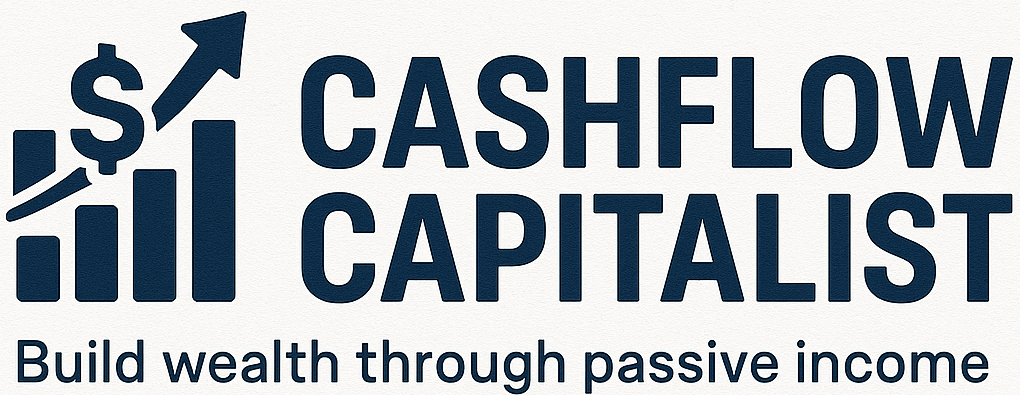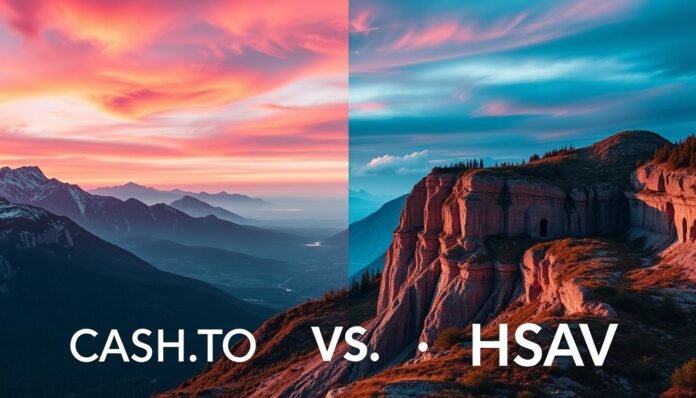Cash ETFs Explained: CASH.TO vs HSAV – Which Canadian ETF Is Better for Your Idle Cash in 2025?
Canadians are looking for ways to grow their savings. Cash ETFs are a popular choice. They invest in short-term, low-risk securities. This offers good yields without tying up your money.

High-interest savings ETFs are becoming more common in Canada. Investors have more options than ever. Two top Canadian cash ETFs are being closely watched for their performance and benefits for short-term savings.
This guide will explore these Canadian cash ETFs. We’ll compare their features to help you choose the best one for your financial goals in 2025.
Key Takeaways
- Cash ETFs offer a flexible way to earn competitive yields on idle cash.
- Canadian cash ETFs are gaining popularity as a short-term savings solution.
- Comparing top cash ETFs can help investors make informed decisions.
- High-interest savings ETFs provide an attractive alternative to traditional savings accounts.
- Understanding the features of each ETF is key to choosing the best one for your needs.
The Growing Popularity of Cash ETFs in Canada
In Canada, cash ETFs are becoming more popular. They offer stability and quick access to money. This makes them a favorite among investors.

What Are Cash ETFs and How Do They Work?
Cash ETFs are special funds that are low-risk. They invest in short-term debt like treasury bills. This way, they provide a safe place for investors to put their money.
These funds are traded on stock exchanges. This means investors can buy and sell them during the day. It makes them easy to use.
Why Investors Are Parking Short-Term Funds in Cash ETFs
More investors are choosing cash ETFs for their short-term money. Cash ETFs offer better interest rates than regular savings accounts. This makes them a good choice for those who want to earn more without taking big risks.
Safety and Accessibility Benefits
Cash ETFs are safe and easy to get to. They hold high-quality, short-term securities. This makes them perfect for keeping money safe while earning a bit of interest.
They are also very liquid. This means investors can quickly get their money if they need it. It’s a big plus for those who value quick access to their funds.
CASH.TO vs HSAV: Core Features Compared
Canadian investors looking to grow their cash should know about CASH.TO and HSAV. These are top cash ETFs in Canada. They have different strategies and fees.
Global X High Interest Savings ETF (CASH.TO) Overview
The Global X High Interest Savings ETF, or CASH.TO, offers a safe investment with good interest rates. CASH.TO invests in high-interest savings and other safe financial tools. It’s known for being flexible and easy to use, letting investors get their money when they need it.
Horizons High Interest Savings ETF (HSAV) Overview
The Horizons High Interest Savings ETF, or HSAV, also aims for safe and good returns. HSAV puts money in high-interest savings and short-term bonds. HSAV is known for its steady and reliable income, attracting cautious investors.
Key Structural Differences
CASH.TO and HSAV differ mainly in their investment strategies and fees. Both aim for high yields but in different ways.

Knowing these differences helps investors choose wisely based on their goals.
Yield Performance Analysis: Which ETF Pays More?
Investors often look at CASH.TO and HSAV when deciding where to put their cash. Both offer good yields, but their performance changes with the market.
Historical Yield Comparison (2022-2024)
CASH.TO and HSAV have had similar yields over the years, with small changes. Here’s a table showing their yields from 2022 to 2024.
| Year | CASH.TO Yield (%) | HSAV Yield (%) |
|---|---|---|
| 2022 | 2.50 | 2.45 |
| 2023 | 4.20 | 4.15 |
| 2024 | 4.50 | 4.40 |
Current Yield Rates in 2025
In 2025, CASH.TO offers a 4.60% yield, and HSAV offers 4.55%. These rates show the current interest rates and the ETFs’ strategies.

Performance in Different Interest Rate Environments
The performance of CASH.TO and HSAV changes with interest rates. It’s important for investors to understand how they react in different rate scenarios.
Rising Rate Scenarios
When rates go up, both ETFs adjust their yields. CASH.TO might offer higher yields in these situations.
Declining Rate Scenarios
When rates fall, HSAV keeps its yield stable. This makes it a good choice for investors who want less risk.
In summary, CASH.TO and HSAV both have good yields, but they perform differently in various market conditions. Investors should think about their financial goals and risk level when picking between these ETFs.
Fee Structure and Cost Implications
The fees of Cash ETFs, like CASH.TO and HSAV, are key to their value. Knowing these costs helps investors make smart choices about their cash investments.
Management Expense Ratios Compared
CASH.TO and HSAV have different MERs, which affect their returns. CASH.TO has a 0.40% MER, while HSAV has a 0.30% MER. This small difference can make a big difference over time.

Impact on Long-Term Returns
A small MER difference can add up over years, changing investment returns. For example, a $10,000 investment can see a big difference in returns over time because of these MERs.
Hidden Costs to Consider
Investors should also look at other costs, like trading fees and taxes. Even though CASH.TO and HSAV aim to be low-cost, knowing these extra costs is important for the best returns.
Key Considerations:
- MER differences can impact long-term returns.
- Trading fees and tax implications are additional costs to consider.
- Comparing the total cost of ownership is essential for choosing the right ETF.
Distribution Policies and Liquidity
Distribution policies and liquidity are key factors that set CASH.TO and HSAV apart in the Canadian ETF market. It’s important for investors to understand these aspects when deciding on their idle cash.
CASH.TO’s Distribution Method and Frequency
CASH.TO pays out its income monthly. This gives investors a steady income stream. It’s great for those who want predictable returns.
HSAV’s Reinvestment Approach
HSAV reinvests its income, which can grow returns over time. This is good for long-term investors aiming to increase their earnings.
Liquidity Comparison
Liquidity is vital in ETF investing. Both CASH.TO and HSAV are liquid, but they differ in trading volume and bid-ask spreads.
Trading Volume Analysis
CASH.TO has a higher trading volume than HSAV. This makes it easier for investors to quickly buy and sell shares.
The bid-ask spread for CASH.TO is narrower than HSAV. This means investors pay less when trading.
Redemption Policies
Both ETFs have similar redemption policies. They allow investors to redeem shares efficiently. But, the details of the redemption process can affect the ETFs’ liquidity.
In summary, CASH.TO and HSAV both have good distribution policies and liquidity. Yet, there are important differences for investors to consider when choosing between them.
Tax Efficiency: CASH.TO vs HSAV in Different Account Types
The tax efficiency of CASH.TO and HSAV changes with different account types. This affects how much money investors can keep. It’s key for Canadian investors to know this to make the most of their cash.
Performance in Non-Registered Accounts
In non-registered accounts, CASH.TO and HSAV face different tax rules. CASH.TO passes income to shareholders, who then pay taxes. HSAV also passes income, but its setup might lead to different tax outcomes for investors.
TFSA Considerations
In Tax-Free Savings Accounts (TFSAs), both CASH.TO and HSAV have tax perks. Earnings aren’t taxed personally. But, remember, there’s a limit to how much you can put in a TFSA, and going over can cost you.
RRSP Considerations
Registered Retirement Savings Plans (RRSPs) let you deduct contributions and grow earnings tax-free. Both ETFs can be in RRSPs. But, think about withholding taxes on foreign investments.
Tax Implications of ETF Structure Differences
The way CASH.TO and HSAV are set up impacts their tax efficiency. Here’s a quick look at the tax implications:
| Account Type | CASH.TO | HSAV |
|---|---|---|
| Non-Registered | Distributions taxed as income | Distributions taxed as income |
| TFSA | Tax-free earnings | Tax-free earnings |
| RRSP | Tax-deferred growth | Tax-deferred growth |
When picking between CASH.TO and HSAV, think about your own situation and account type. Talking to a tax expert can help you save more in 2025.
Alternative Cash ETFs: PSA and CSAV Comparison
Investors looking for more than CASH.TO and HSAV can explore PSA and CSAV. These ETFs give Canadian investors more ways to handle their cash.
Purpose High Interest Savings ETF (PSA)
The Purpose High Interest Savings ETF (PSA) offers a high-interest savings option. PSA’s team works hard to keep liquidity high while earning good returns.
CI High Interest Savings ETF (CSAV)
CI High Interest Savings ETF (CSAV) is another choice for investors. It aims to give stable returns with a mix of high-interest savings products. CSAV tries to keep fees low to boost investor earnings.
How They Stack Up Against CASH.TO and HSAV
PSA and CSAV face off against CASH.TO and HSAV in several areas. Here’s a quick look:
- Yield: PSA and CSAV have competitive yields, but they might not match CASH.TO and HSAV exactly.
- Fees: Fees for PSA and CSAV are similar to CASH.TO and HSAV, ranging from 0.15% to 0.40%.
- Liquidity: All four ETFs are very liquid, making it simple for investors to buy or sell.
Conclusion: Selecting the Best Cash ETF for Your Financial Goals
Canadian investors have many options for the best cash ETF for short-term savings. CASH.TO and HSAV stand out, each with its own benefits. CASH.TO offers high etf interest returns, while HSAV focuses on stable reinvestment.
Choosing the right safe etf canada 2025 depends on your financial goals and strategy. Both CASH.TO and HSAV are highly liquid, making it simple to trade shares. Looking at the etf yield chart can also guide your decision.
The ideal etf for short-term savings varies by individual needs. Consider etf interest returns, liquidity, and fees to find the best fit. CASH.TO and HSAV are top choices in Canada, whether you seek high returns or stability.
FAQ
What are cash ETFs, and how do they work?
Cash ETFs are funds that invest in short-term, low-risk debt. They offer a safe place to keep money. These funds pool money to buy high-quality, short-term debt.
Why are cash ETFs becoming popular in Canada?
In Canada, cash ETFs are popular for their safety and good returns. They’re easy to use and let investors earn interest on their cash.
What is the difference between CASH.TO and HSAV?
CASH.TO and HSAV are both cash ETFs but differ in their goals and fees. CASH.TO is managed by Global X, while HSAV is managed by Horizons ETFs.
How do the yields of CASH.TO and HSAV compare?
The yields of CASH.TO and HSAV change over time. Both offer better rates than traditional savings accounts. Comparing their yields helps investors choose.
What are the management expense ratios (MERs) of CASH.TO and HSAV?
MERs of CASH.TO and HSAV are key to long-term returns. They have different MERs, affecting their performance.
How do CASH.TO and HSAV distribute income?
CASH.TO and HSAV distribute income differently. Knowing these differences is important for investors who need regular income.
Are CASH.TO and HSAV tax-efficient in different account types?
Tax efficiency of CASH.TO and HSAV varies by account type. Investors should consider tax implications in different accounts.
What are the alternatives to CASH.TO and HSAV?
Alternatives like PSA and CSAV offer similar features. Comparing them helps investors find the best cash ETF for their goals.
How do I choose the best cash ETF for my needs?
To choose the best cash ETF, consider yield, fees, and liquidity. These factors are important for your financial goals and strategy.
What are the benefits of using cash ETFs for short-term investments?
Cash ETFs are good for short-term investments. They offer liquidity, safety, and competitive yields. They’re flexible for managing cash and earning interest.
Can I hold cash ETFs in tax-free accounts like TFSAs?
Yes, you can hold cash ETFs in tax-free accounts like TFSAs and RRSPs. Understanding tax implications is important.




